A couple of months back I polled some of you on sous vide cooking in a steam oven. You overwhelmingly responded that the first thing you wanted to know about was how to sous vide steak in a steam oven, so that’s what we’re talking about today!
Rather than just cook a couple of steaks in the steam oven and call it done, I got all excited and decided I’d experiment with sous vide steak by cooking it three different ways and doing a blind taste test.
I wanted to know (and I suspect many of you will, too) whether steam oven sous vide cooking actually works well.
More than that, I wondered if it was possible to make a decent sous vide steak without putting it into a sealed plastic bag for cooking. I’m not averse to cooking in certain types of plastic occasionally from a food safety perspective, but I do have environmental concerns about how much of the stuff we use. If using my steam oven to sous vide without the bag* tasted as good as the sealed version, I figured it’d be a huge win.
I tried three pretty much identical boneless ribeye (Scotch fillet) steaks. One was vacuum sealed and put in the steam oven, one unbagged on a tray in the steam oven and, just for kicks, the final ‘control’ steak was vacuum sealed and cooked in a water bath, the traditional method for sous vide.
Spoiler alert: all the steaks were fabulous, though there were subtle differences between each. Keep reading for all the juicy (pun definitely intended) details.
*Technically, if you’re cooking without a sealed bag you aren’t doing sous vide (see below), but given it’s become the common term for this type of low temperature cooking I’m going to stick with it here.
Full disclosure: I was kindly gifted a precision cooker by Anova, which I used in helping to create this article. I was not otherwise compensated by Anova for this post, and all the information which follows is my own opinions based on first-hand use.
This post includes affiliate links. I am an Anova affiliate, and I may make a commission if you purchase one of their products from the article links. Additionally, as an Amazon affiliate I earn from qualifying purchases. Find out more about affiliate links.
What is sous vide cooking?
Before we go too far, I’m aware not everyone has heard of sous vide, so let’s briefly cover that.
Directly translated, the French term sous vide means ‘under vacuum’, which means to cook food that’s sealed inside a bag with all the air removed. The method uses very precise cooking temperatures, held for a long time, to produce food textures and tastes that aren’t possible with other methods of cooking.
Successful sous vide is about temperature and time of cooking, but the vacuum sealing of the food can play a role too, in terms of texture and also when it comes to infusing flavor into whatever you’re cooking.
Traditionally, sous vide cooking has been done in a temperature-controlled water bath, which is designed to remain accurate and stable throughout cooking.
Large and expensive sous vide cookers (imagine something that looks like like an oversized slow cooker filled with water) have given way in the past several years to more compact immersion circulators like Anova’s. These are ideal for home use and can be simply used in a deep saucepan, pot or heat-safe plastic tub. The option to sous vide in a steam oven is another possibility (more on that below).
What’s the point of sous vide?
If you haven’t heard of it before sous vide cooking might sound weird.
When you can cook a perfectly good steak in a few minutes using a grill or a hot pan, it might seem as though cooking the same thing for possibly hours is a lot of fuss to make dinner.
As with any method of cooking, sous vide won’t suit every type of food or every cook. But it is a great way to cook a range of different foods, from meats and chicken to seafood, vegetables, fruits, eggs, sauces and even amazing desserts like cheesecake or custards.
Being able to control the exact temperature your food cooks at gives you consistency and the ability to achieve textures you otherwise couldn’t.
In a lot of cases, cooking sous vide also means you can mostly prepare a dish hours or even days ahead of time, reheating or searing quickly just before serving. This is a brilliant thing when you’re cooking for a crowd and don’t want to be slaving in the kitchen while your guests are all having fun.
You can absolutely just grill or barbecue a steak like you always have. But if you like the idea of being able to cook that steak to exactly the doneness you prefer, all the way through, every single time you cook it, sous vide is a great method to achieve it.
Can you really cook sous vide in a steam oven?
Yes, you really can.
I know many of you who visit this site are here because you want to learn more about cooking in a steam oven. And just when you thought maybe you were getting a handle on how your oven works, I’m throwing out weird new cooking terms and telling you that you can do a whole other kind of cooking in there.
Stay with me (I’ll make it worthwhile).
Basically, as steam ovens have become more popular, some manufacturers have started promoting the ability of their ovens to cook sous vide by using a low temperature steam setting, eliminating the need for a water bath altogether.
This is a great solution if you own a steam oven and you want to test out sous vide without buying any more equipment.
Here’s the down side: most steam ovens don’t offer the same precision when it comes to temperatures as a circulator or sous vide cooker will. Sous vide specific appliances generally operate in single degree or even tenths of a degree increments.
The best case scenario when it comes to a steam oven is one with single degree temperature control. Some only offer increments of five degrees. This isn’t a big deal if you’re cooking something where a few degrees of difference doesn’t matter, but for many sous vide dishes it really matters. Rare meats, seafoods, and eggs are more altered by small temperature changes than, say, carrots or asparagus, or a slow cooked joint of meat.
Other recipes to try if you want to test out sous vide in your steam oven:
Sous Vide Pork Belly with Watermelon Salad
Mexican Poached Chicken Salad (sous vide chicken)
Do you want to use and love your steam oven more?
There are precious few resources to teach us HOW to use a steam oven in everyday cooking. I’m guessing that’s why you’re here! If you love cooking but aren’t making the most of your combi steam oven, you aren’t alone.
Steam Oven Insiders was created for you!
Benefit from my decade-plus of steam oven knowledge and training, delivered to your inbox twice monthly in bite sized, easy-to-implement tips and delicious recipes you’ll actually want to cook. Insiders get access to every exclusive recipe and article within the members dashboard, so you’ll never miss a thing.
Find out more right here
What about all that plastic?
Sous vide cooking, traditionally, is done inside a plastic vacuum bag or a resealable food storage bag (also plastic).
In a water bath the bag protects the food so it can be immersed without the food disintegrating, dissolving or getting waterlogged. In other words, the plastic bag is very necessary.
But what if you have health concerns about plastic surrounding your food while it cooks, or you just hate the idea of single use plastics from an environmental perspective?
As far as the health concerns over plastic go, that’s something you’ll need to make up your own mind about.
There are some kinds of plastic which are terrible and should never be heated near food. Some brands of plastic wrap, for instance, contain bisphenol-A (BPA), plasticizers and a bunch of other stuff none of us want near our food.
Then there are other plastics like polyethylene and polypropylene, which have been deemed safe for food use. That is, they don’t contain BPA and have been approved by the FDA in America (and other countries’ relevant health authorities) for food storage and preparation purposes. Almost all vacuum and storage bags are made from high or low-density polyethylene.
There is some evidence that even BPA-free plastics can potentially leach hormone disrupting chemicals when heated, but it doesn’t seem to be clear how much. If this is something which concerns you, I’d recommend reading as much as possible on the topic and taking up sous vide cooking only if you’re comfortable with the available information.
When it comes to single use plastics and environmental concerns, I have clearer cut and happy news for you: there are bags on the market now which can be washed and reused many times, and even some of the high quality vacuum bags can be cleaned and reused if you’re willing to take that approach. Silicone zip lock bags can’t be vacuum sealed but they can be used for many sous vide dishes without any problems at all. You simply lower the filled, open bag partway into a pot of water to expel all the air around the food, then zip the bag closed.
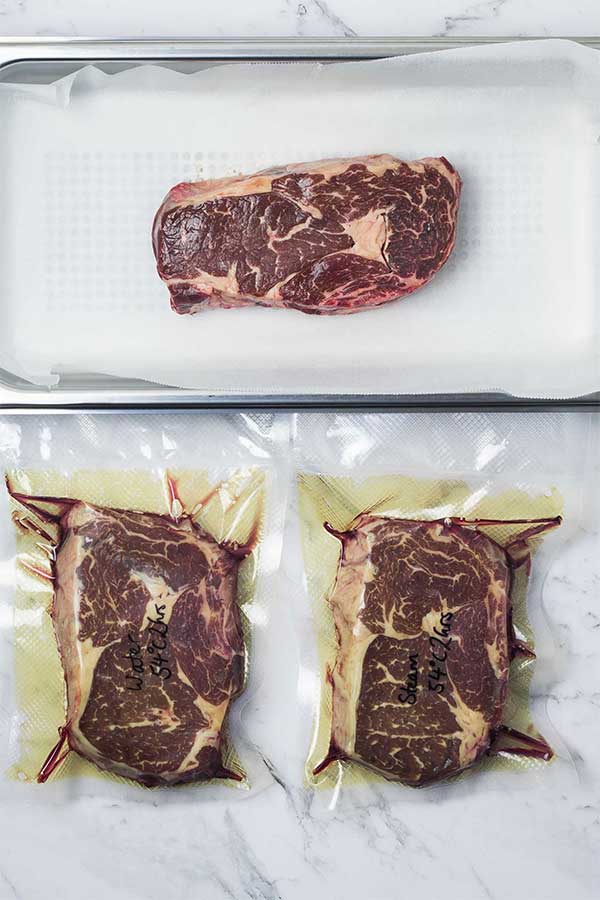
How long to sous vide steak, and at what temperature
Let’s get down to the cooking, shall we?
When I was starting to explore this method and wondering how to sous vide steak so it would be perfectly cooked, tender and not inflict food poisoning, I find J. Kenji Lopez-Alt’s articles incredibly helpful. I highly recommend you take a look too.
In short, the easiest way to think about this is that temperature equals doneness and time equals tenderness of meat. The time factor means not only does your meat reach the correct temperature, but the longer it holds at that temperature the more the connective tissues and fat can break down.
Temperature
To get a rare to medium rare result, I cooked my steaks at 130°F/54°C for 2 hours apiece.
If you want very rare (blue) to rare doneness, go with 122-128°F/50-53°C (no more than 2½ hours at these temps – see below).
For medium, try 135-144°F/57-62°C and for medium well you’ll want somewhere between 145-155°F/63-68°C.
You can cook a well done steak sous vide, but to be honest I wouldn’t bother. You don’t need the same level of precision to cook your meat to brown all the way through, so you’ll be better off just grilling it.
Timing
There is a limit to how long it’s safe to cook meat at very low temperatures. To stay on the correct side of food safety, don’t cook a steak at less than 130°F/54°C for more than 2½ hours.
Once you go above 130°F/54°C you can play around with timing more readily. A shorter time (1-2 hours) will give you a steak that’s cooked precisely but not altered much in terms of texture – perfect for something already tender and very lean like tenderloin/eye fillet.
When you increase that cooking time, steaks become more tender. For prime cuts like strip/sirloin and ribeye/Scotch fillet, I find the optimum time is generally somewhere between 2 and 4 hours. In theory, you could leave a steak (as long as it’s at a higher temp than 130°F/54°C) to cook almost indefinitely, but after about 8 hours they begin to break down and become more like pulled meat than the steak texture we’re used to.
The only time I’d leave a steak in to cook overnight or longer would be if it were a tough cut like skirt or short ribs, and I wanted it to soften and shred easily.
The dirty details – which steaks I used and how I cooked them
As I mentioned up top, for today’s post I cooked three boneless ribeye steaks. They were all the same thickness, around an inch and a half, and all cut from the same joint.
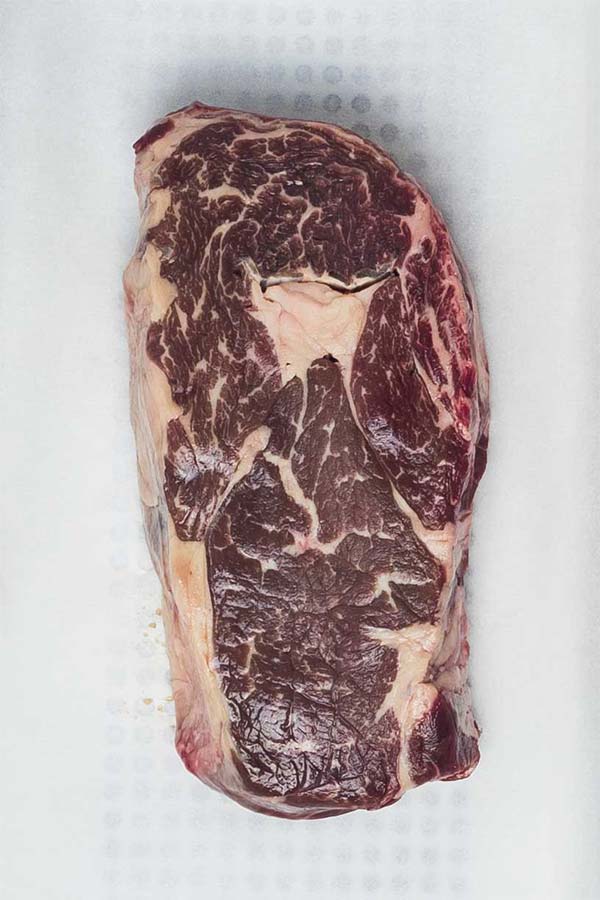
I really recommend using thick cut steaks for sous vide. You’ll need to sear them after cooking to add a gorgeous browned crust to the outside, and if they’re very thin you’ll likely overcook them when you sear.
All three steaks were salted generously on both sides before cooking, and cooked at 130°F/54°C for two hours. On other occasions I’ve also added fresh thyme or rosemary sprigs to the steak before cooking, but this time I didn’t bother.
Beyond that, each steak received a slightly different treatment for cooking. One was vacuum sealed and put into a water bath with my Anova sous vide device; one was vacuum sealed and put into a preheated steam oven; and the final steak was put on a lightweight oven tray, covered loosely with aluminium foil and into the same preheated steam oven as the bagged version.
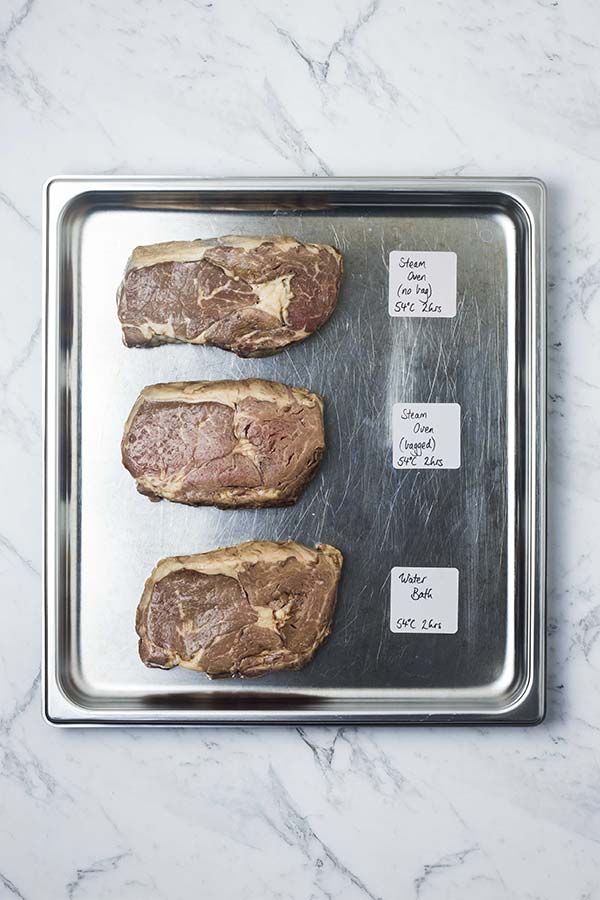
After cooking, I removed the steaks from their cooking vessels and patted each one dry with paper towel. I added a little more salt and seared them in a very hot steel skillet, turning about every 20 seconds until they had a decent crust (I use a well-seasoned SolidTeknics Aus-Ion pan for almost all fry pan cooking these days).
The results
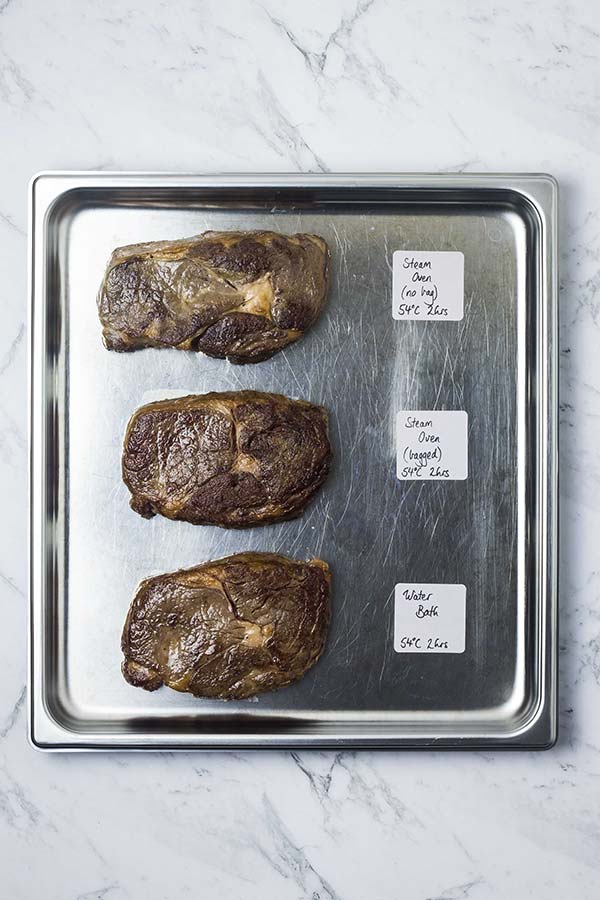
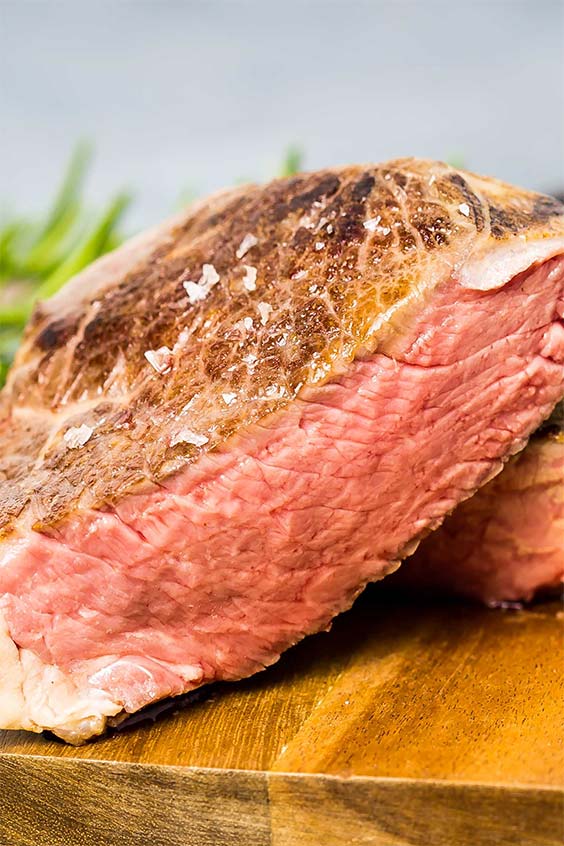
Each cooking method gave marginally different results, but I’m happy to report all three worked beautifully.
Sous vide steak, vacuum sealed, in a water bath
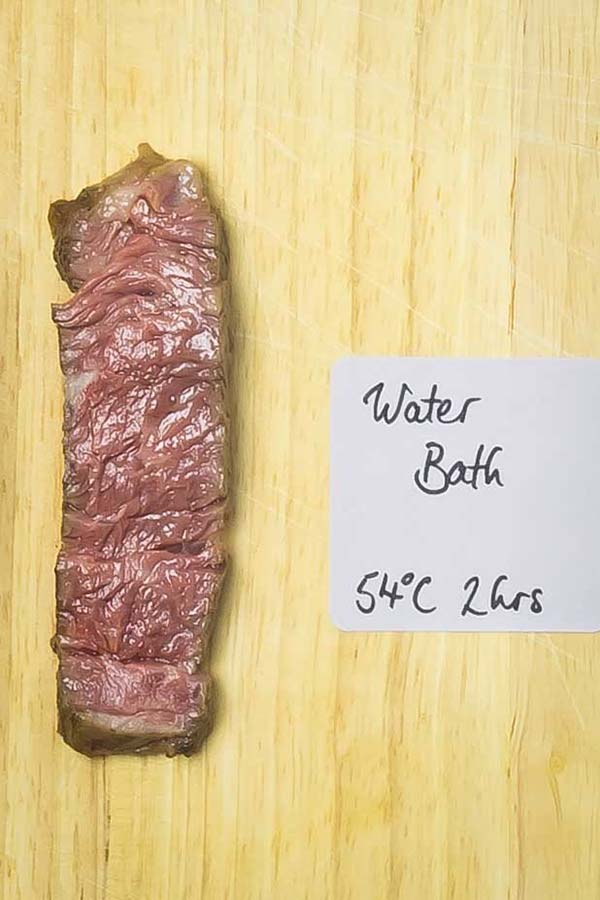
This was my control steak, given that vacuum sealed water bath cooking is the standard for sous vide. As expected, it produced a steak that was perfectly cooked, juicy and tender.
The fibers of this steak were soft but not mushy, so the overall texture was ‘steaky’ with a little chew – just enough to be pleasant but not so much that your jaw has to do any hard work.
Sous vide steak, vacuum sealed, in a steam oven
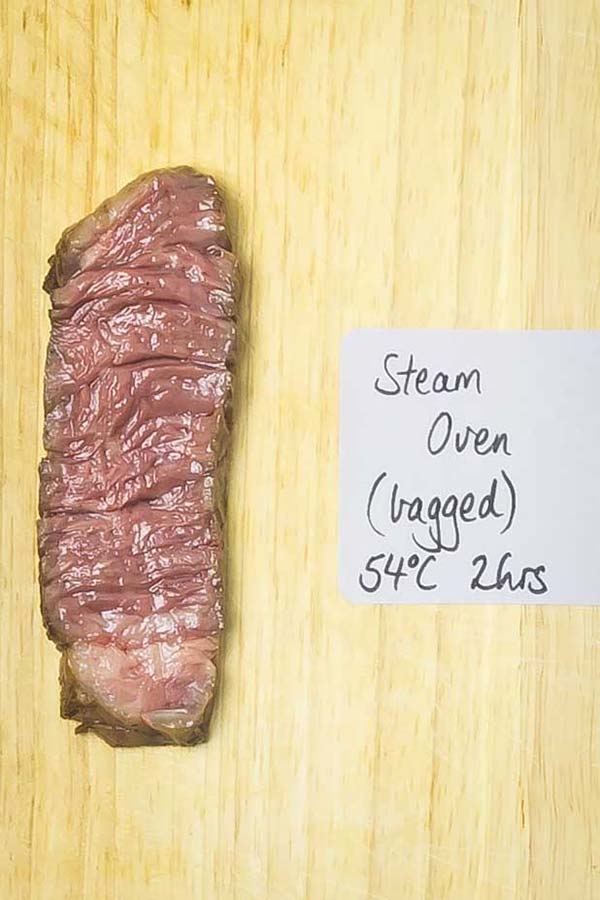
This steak showed virtually no difference in texture or taste to the water bath version, which is a good indication that my steam oven’s thermostat is accurate and maintains temperature well.
If you own a higher end steam oven with single degree temperature control and decent thermostat accuracy you should have no problem achieving the same results I did. If, however, you’re working with a less accurate steam oven or one with less sensitive temperature control, you might find your steak is more difficult to get exactly how you want it.
If you’ve got no idea how accurate your oven’s temperature is, a check with a digital thermometer or even a simple in-oven dial thermometer should tell you if it’s on the mark.
Sous vide steak, on a tray, in a steam oven (no bag)
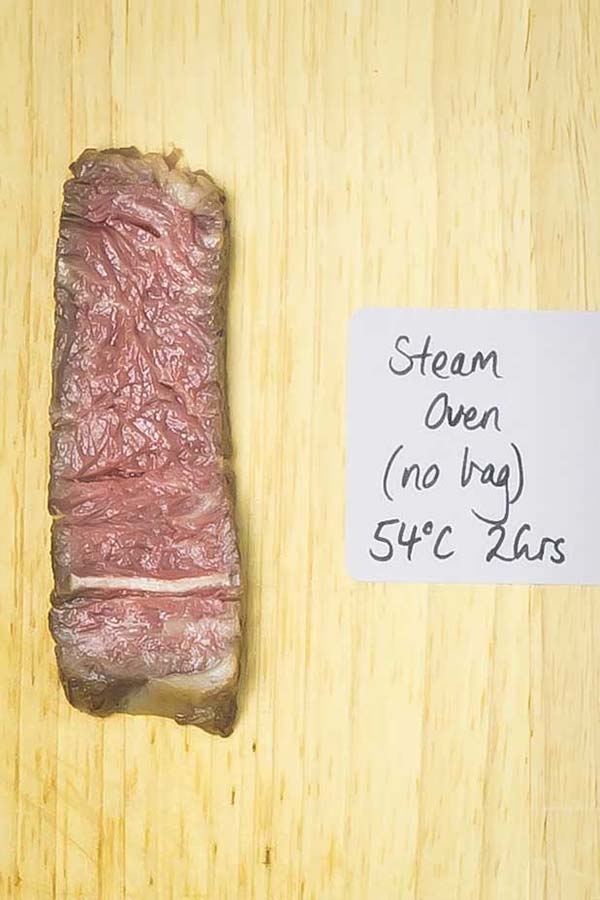
This steak was a little different to the bagged ones but less so than I’d expected.
The biggest difference with this steak was that it tasted a little less meaty compared to the other two. The difference was small, and I’m not sure it would be noticeable if you weren’t trying the direct comparison of a bagged steak bite-for-bite, but there you go.
My best non-food-scientist guess is that the less meaty flavor comes from a combination of two factors: firstly, the lack of bag means the juices which come out of the meat during cooking aren’t contained directly around the surface of the steak as they would be in a bag, rather they run off to the bottom of the tray. The second thing is that the moist cooking environment dilutes any seasoning you add to the steak prior to cooking (those are going to run off with the aforementioned juices), and dampens the surface of the meat.
If you’re anti plastic bags but want to try sous vide style cooking, I’d still recommend this method as a comparable way to achieve a similar result. It yields a far better and more consistent steak than most grilled or pan-fried ones I’ve tried.
Overall, if you really want to include seasonings, especially fresh herbs, when you sous vide a steak, I’d stick with cooking in a bag. The aroma of the herbs penetrates into the meat better under vacuum, and any salt or pepper will remain close to the surface of the meat instead of ‘washing off’ with the oven’s moisture.
If you decide to try sous vide in your steam oven and have questions, let me know! I’ll update this post as I can with extra info.
Over to you – if you try one of these methods I’d love to know about it! Share your comments below or on Facebook, tag @steamandbake on Instagram, or pin all your favourite Steam and Bake recipes over on Pinterest!
Would you like more recipes and tips to help you cook with confidence? Join the mailing list to get my steam oven cheat sheets and to be alerted to new posts.

